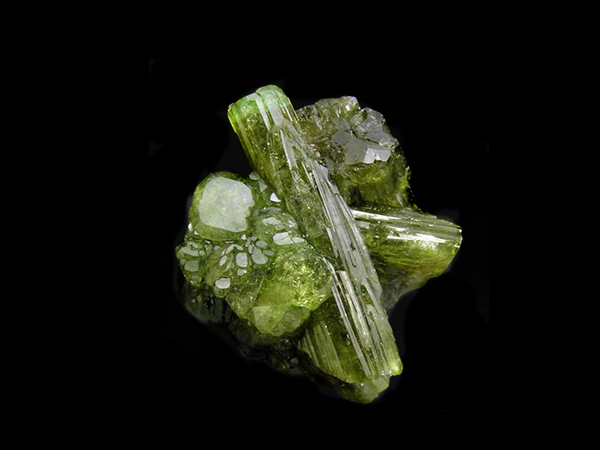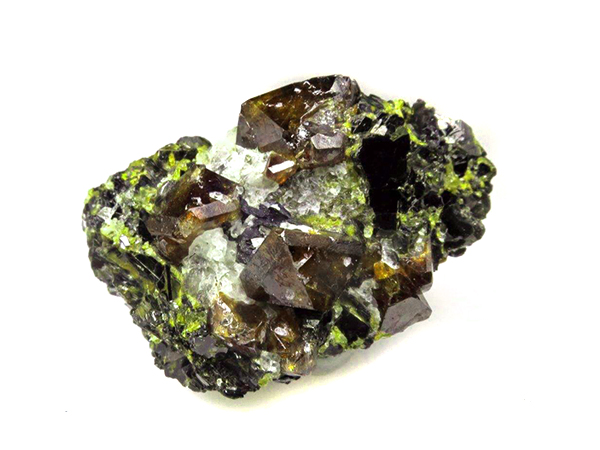IDOCRASE

Introduction
Fushan Stone Overview
The chemical formula is Ca10(Mg,Fe)Al4[Si2O7]2[SiO4]5(OH,F)4, tetragonal system, space group D4 4h-P4/nnc, crystal is quadrangular column and tetragonal double-cone shape, flat square Columnar, also often in the form of granules, rods or dense block aggregates.
Fushan stone crystals are often yellow, gray, olive green and brown, green when containing chromium, reddish brown or pink when containing titanium and manganese, greenish blue when containing copper, glass luster, mostly translucent; Positive or negative light; cleavage incomplete; shell-like to staggered fracture; refractive index of 1.713 to 1.718 (+0.003, -0.013), birefringence of 0.001 to 0.012; Mohs hardness of 6.5 to 7, fragile , density 3.33 ~ 3.43g / cm; fluorescence inert under ultraviolet; absorption spectrum: 464nm absorption line, 528.5nm weak absorption line.
The rare blue copper-bearing cyprine is produced in Norway; the xanthite is produced in New York, USA; the light green boron-containing mountain (wiluite) is produced in the Russian Viliuyi region. Transparent Fushan stone crystals are rare gemstones in the gem field, and even cut into faceted gemstones for collection.
Fushan Shiyu Overview
Fushan Shiyu is a jade composed mainly of Fushan stone mineral aggregates. It was first discovered in California, and is known as californite.
Fushan Shiyu is mainly produced in the United States, Italy, Pakistan and other places. In recent years, it has appeared in China's jade market. China's Tongbai Huilong area produces skarn type Fushan Shiyu-Huilongyu, Xinjiang Manas area. Also produced Fushan stone jade. In addition, Myanmar also produces Fushan stone jade, which can be associated with jadeite.
Fushan stone jade usually has yellow-green-green, yellow to yellow-brown to brown, and the color varies widely. The yellow-green Fushan stone jade generally has uneven color, and some green bands or point minerals appear locally. Fushan Shiyu is generally translucent and has a glassy appearance. The appearance after polishing is very similar to that of jade.
The Fushan Shiyu point method has a refractive index of 1.71 to 1.72 and a density of 3.32 to 3.47 g/cm. The olive green and brown-yellow Fushan stone jade absorption spectrum has a strong absorption band at 461 nm, and 528.5 nm has a weak absorption band, while the brown variety Fushan stone jade has multiple rare earth lines between 591 nm and 574.5 nm. The strong absorption band at 461nm of Fushan Shiyu can be used to distinguish it from jadeite.
Physicochemical properties
Chemical composition: Ca10Mg2Al4 (SiO4)5(Si2O7)2(OH)4, which may contain elements such as Cu and Fe
Crystalline state: crystal body
Crystal system: tetragonal system
Crystal habit: columnar crystal, massive aggregate

Gloss: glass luster
Cleavage: Incomplete
Mohs hardness: 6 to 7.
Density: 3.40 ( +0.10 , - 0.15 ) g / cm 3
Photographic characteristics: heterogeneous, monoaxial, orthorhombic or negative
Polychromaticity: no weakness, depending on color
Refractive index: 1.713 ~ 1.718 (+0.003, -0.013), the point is often 1.71
Birefringence: 0.001 ~ 0.012
UV fluorescence: none
Absorption spectrum: 464nm absorption line, 528.5nm weak absorption line
Magnification check: gas-liquid inclusions, mineral inclusions
Special optical effects: not seen
Optimization processing: unknown
Refractive index: 1.71-1.72
Density: 3.32-3.45
Mohs hardness: 6.5-7
The visible light absorption spectrum of green Fushan stone jade has obvious absorption line at 460mm.
Relevant information
Occurrence
Fushan Stone is a heterogeneous mineral. Its crystal structure and chemical formula are similar to those of calcium aluminum garnet. The obvious difference is that Fushan Stone has heavy tortuosity and can display abnormal interference color of blue or brown. Fushan Stone can be symbiotic with minerals such as diopside, garnet, wollastonite, etc., and sometimes can be formed in metamorphic rocks. It was once found in the Hualien Toyota mining area to be symbiotic with nephrite.
use
The beauty of color and texture can be used for ornamental purposes.
Place of origin
The first Vesuvius volcano found in Italy. There are outputs on the Afghan border, Norway, the United States and other places. The green, yellow-green dense block-shaped Fushan stone produced by California in the United States has a fine texture and is called California jade. There is a huge crystal output in Hebei, China. The Manas area in Xinjiang also produced Fushan stone jade. In addition, Myanmar also produces Fushan stone jade, which can be associated with jadeite.
The difference between Fushan Stone and Jadeite
1. The refractive index of Fushan Stone is obviously larger than that of jadeite. According to the point method, Fushan Stone is 1.71, while jadeite is generally 1.66. It is difficult to see the grain boundary of the magnifying stone. It is not easy to see the intertwined structure of the granular fiber unique to the jade. Under the beam splitter, the 465 nm absorption band can be clearly seen in the Fushan stone, while the jadeite is visible at 437 nm.
2. The infrared spectra of Fushan Stone and Jadeite are very different, and there are significant differences in the number and shape of the bands and the wavenumber characteristics of the absorption bands (Table 3). In particular, there is no light base in the chemical composition of jadeite (Jadeite), so it is in the high frequency region of 3400-3800cm - no absorption band appears, and Fushan stone has a strong absorption band in this range because it contains light base. This is the key to distinguishing Fushan Stone and Emerald.
3, the green Fushan stone jade is very similar in color and texture to the superior quality jade, but the color distribution is more uniform than the jade, and the color is lighter.
Identification and judgment suggestion: The color of Fushan stone seems to be self-color, the original color, the color is more uniform, the bottom is generally thin, and the jade color is the secondary color, the color is uneven in most cases, the color along the crack Or intergranular gap distribution, and the bottom is generally thicker, usually with graininess. If a piece of yellow enamel is very uniform and the bottom is very delicate, then the possibility of jade is extremely small.
Fushan Stone, after all, is not jade, although their shapes are somewhat similar, density and hardness are similar, as long as they are carefully identified, there is still a big difference in refractive index and internal structural characteristics. The infrared and X-ray diffraction patterns of Fushan Stone and Jadeite are also very different.